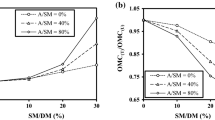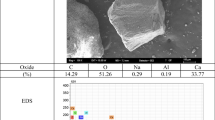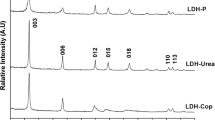Abstract
The role of nanozinc source (nanohydrozincite: nHZ; nanozinc oxide: nZO) on the performance of alkali-activated slag (AAS) was explored for the first time in the present work. The results showed that nHZ with different contents (0.5, 1.0, and 1.5 wt%) retards the early hydration rate of AAS, whereas nZO showed the lowest retardation effect. Zn(OH)2 is the main retarder inside AAS-nZO and AAS-nHZ, which consumes the dissolved Ca2+ (responsible for the early hardening of AAS) from slag to yield calcium zincate hydrate (CZH). The high retardation rate of nHZ is originated from its high affinity to consume much Ca2+ through the formation of additional pirssonite (Na2CO3.CaCO3.2H2O) double salt. Although adding nHZ induced the drying shrinkage of AAS, it improved the later compressive strengths (28 to 365 days), especially at low nHZ content (0.5 wt%), via the formation of CASH with lower Ca/Si ratio and higher binding capacity compared to that formed inside AAS and AAS-nZO. A further research is needed to reduce the drying shrinkage and to accelerate the early strength of AAS containing nHZ.












Similar content being viewed by others
Data availability
All data and materials will be available upon request.
References
Abdel daiem MM, Rashad AM, Said N, Abdel-Gawwad HA (2021) An initial study about the effect of activated carbon nano-sheets from residual biomass of olive trees pellets on the properties of alkali-activated slag pastes. J Build Eng 44:102661
Abdel-Gawwad HA, Mohammed MS, Alomayri T (2019) Single and dual effects of magnesia and alumina nano-particles on strength and drying shrinkage of alkali activated slag. Constr Build Mater 228:116827
Abdel-Gawwad HA et al (2020) Biocarbonation: A novel method for synthesizing nano-zinc/zirconium carbonates and oxides. Arab J Chem 13(11):8092–8099
Abdel-Gawwad HA, Khalil KA, Gouda AA, Elkhoresy AH, Arif MA (2022) Understanding the effect of hydrozincite and witherite nanominerals on the performance and phase composition of alkali-activated slag. J Build Eng 48:103963
Adesina A (2021) Performance and sustainability overview of sodium carbonate activated slag materials cured at ambient temperature. Res Environ Sustain 3:100016
ASTM C109M. Standard test method for compressive strength of hydraulic cement mortars (2021).
ASTM C490/C490M. Standard Practice for Use of Apparatus for the Determination of Length Change of Hardened Cement Paste, Mortar, and Concrete (2021).
Atiş CD, Bilim C, Çelik Ö, Karahan O (2009a) Influence of activator on the strength and drying shrinkage of alkali-activated slag mortar. Constr Build Mater 23(1):548–555
Atiş CD et al (2009b) Influence of activator on the strength and drying shrinkage of alkali-activated slag mortar. Construc Build Mater 23(1):548–555
Aydın S, Baradan B (2012) Mechanical and microstructural properties of heat cured alkali-activated slag mortars. Mater Des 35:374–383
Aydın S, Baradan B (2014) Effect of activator type and content on properties of alkali-activated slag mortars. Compos B Eng 57:166–172
Aydın S, Baradan B (2021) Sulfate resistance of alkali-activated slag and Portland cement based reactive powder concrete. J Build Eng 43:103205
Behfarnia K, Rostami M (2017) Effects of micro and nanoparticles of SiO2 on the permeability of alkali activated slag concrete. Constr Build Mater 131:205–213
Bílek V Jr, Kalina L, Markusík D (2022) Fresh properties of alkali-activated slag pastes with sodium and potassium hydroxide. Special Publication 355:19–28
Cartwright C, Rajabipour F, Radlińska A (2015) Shrinkage characteristics of alkali-activated slag cements. J Mater Civ Eng 27(7):B4014007
Dai X, Aydin S, Yardimci MY, De Schutter G (2022) Early structural build-up, setting behavior, reaction kinetics and microstructure of sodium silicate-activated slag mixtures with different retarder chemicals. Cem Concr Res 159:106872
Davidovits J (2020) Geopolymer chemistry and applications. Institut, Saint-Quentin, France
El-Hassan H, Shehab E, Al-Sallamin A (2021) Effect of curing regime on the performance and microstructure characteristics of alkali-activated slag-fly ash blended concrete. J Sustain Cement-Based Mater 10(5):289–317
Eren NA, Alzeebaree R, Çevik A, Niş A, Mohammedameen A, Gülşan ME (2021) Fresh and hardened state performance of self-compacting slag based alkali activated concrete using nanosilica and steel fiber. Journal of Composite Materials. 00219983211032390
Garg N, White CE (2017) Mechanism of zinc oxide retardation in alkali-activated materials: an in situ X-ray pair distribution function investigation. Journal of Materials Chemistry A 5(23):11794–11804
Gu YM, Fang YH, You D, Gong YF, Zhu CH (2015) Properties and microstructure of alkali-activated slag cement cured at below-and about-normal temperature. Constr Build Mater 79:1–8
He J, Zheng W, Bai W, Hu T, He J, Song X (2021) Effect of reactive MgO on hydration and properties of alkali-activated slag pastes with different activators. Constr Build Mater 271:121608
Hu X, Shi C, Zhang Z, Hu Z (2019) Autogenous and drying shrinkage of alkali-activated slag mortars. J Am Ceram Soc 102(8):4963–4975
Jin F, Gu K, Al-Tabbaa A (2014) Strength and drying shrinkage of reactive MgO modified alkali-activated slag paste. Constr Build Mater 51:395–404
Júnior NTA, Lima VM, Torres SM, Basto PE, Neto AAM (2021) Experimental investigation of mix design for high-strength alkali-activated slag concrete. Constr Build Mater 291:123387
Krizan D, Zivanovic B (2002) Effects of dosage and modulus of water glass on early hydration of alkali–slag cements. Cem Concr Res 32(8):1181–1188
Kumarappa DB, Peethamparan S, Ngami M (2018) Autogenous shrinkage of alkali activated slag mortars: Basic mechanisms and mitigation methods. Cem Concr Res 109:1–9
Kunther W et al (2017) Influence of the Ca/Si ratio on the compressive strength of cementitious calcium–silicate–hydrate binders. J Mater Chem A 5(33):17401–17412
Liang G, Liu T, Li H, Wu K (2022) Shrinkage mitigation, strength enhancement and microstructure improvement of alkali-activated slag/fly ash binders by ultrafine waste concrete powder. Compos B Eng 231:109570
Liu B, Yang J, Li D, Xing F, Fang Y (2018) Effect of a synthetic nano-CaO-Al2O3-SiO2-H2O gel on the early-stage shrinkage performance of alkali-activated sag mortars. Materials 11:1128
Majhi RK, Nayak AN (2019) Bond, durability and microstructural characteristics of ground granulated blast furnace slag based recycled aggregate concrete. Constr Build Mater 212:578–595
Majhi RK, Nayak AN, Mukharjee BB (2020) Characterization of lime activated recycled aggregate concrete with high-volume ground granulated blast furnace slag. Constr Build Mater 259:119882
Majhi RK, Nayak AN, Swain RB (2021) Structural performance of RC beams containing high-volume ground granulated blast furnace slag and recycled coarse aggregate with lime. Constr Build Mater 307:124907
Matalkah F, Ababneh A, Aqel R (2022) Effects of nanomaterials on mechanical properties, durability characteristics and microstructural features of alkali-activated binders: a comprehensive review. Constr Build Mater 336:127545
Mohebi R, Behfarnia K, Shojaei M (2015) Abrasion resistance of alkali-activated slag concrete designed by Taguchi method. Constr Build Mater 98:792–798
Mohsen A et al (2020) Performance, radiation shielding, and anti-fungal activity of alkali-activated slag individually modified with zinc oxide and zinc ferrite nano-particles. Construc Build Mater 257:119584
Neto AAM, Cincotto MA, Repette W (2008) Drying and autogenous shrinkage of pastes and mortars with activated slag cement. Cem Concr Res 38(4):565–574
Niş A, Eren NA, Çevik A (2021) Effects of nanosilica and steel fibers on the impact resistance of slag based self-compacting alkali-activated concrete. Ceram Int 47(17):23905–23918
Ortega-López V, Revilla-Cuesta V, Santamaría A, Orbe A, Skaf M (2022) Microstructure and dimensional stability of slag-based high-workability concrete with steelmaking slag aggregate and fibers. J Mater Civ Eng 34(9):04022224
Ou Z, Feng R, Li F, Liu G, Li N (2022) Development of drying shrinkage model for alkali-activated slag concrete. Constr Build Mater 323:126556
Panda B, Ruan S, Unluer C, Tan MJ (2020) Investigation of the properties of alkali-activated slag mixes involving the use of nanoclay and nucleation seeds for 3D printing. Compos B Eng 186:107826
Ramezanianpour AA, Moeini MA (2018) Mechanical and durability properties of alkali activated slag coating mortars containing nanosilica and silica fume. Constr Build Mater 163:611–621
Ren J, Sun H, Li Q, Li Z, Ling L, Zhang X, ..., Xing F (2021) Experimental comparisons between one-part and normal (two-part) alkali-activated slag binders. Constr Build Mater 309:125177
Revilla-Cuesta V, Evangelista L, de Brito J, Skaf M, Ortega-López V (2022a) Mechanical performance and autogenous and drying shrinkage of MgO-based recycled aggregate high-performance concrete. Constr Build Mater 314:125726
Revilla-Cuesta V, Ortega-López V, Skaf M, Manso JM (2022b) Deformational behavior of self-compacting concrete containing recycled aggregate, slag cement and green powders under compression and bending: Description and prediction adjustment. J Build Eng 54:104611
Revilla-Cuesta V, Skaf M, Santamaría A, Romera JM, Ortega-López V (2022c) Elastic stiffness estimation of aggregate–ITZ system of concrete through matrix porosity and volumetric considerations: explanation and exemplification. Archives of Civil and Mechanical Engineering 22(2):1–17
Saleh AA et al (2021) The sustainable utilization of weathered cement kiln dust in the cleaner production of alkali activated binder incorporating glass sludge. Construc Build Mater 300:124308
Shahrajabian F, Behfarnia K (2018) The effects of nano particles on freeze and thaw resistance of alkali-activated slag concrete. Constr Build Mater 176:172–178
Shariati M, Shariati A, Trung NT, Shoaei P, Ameri F, Bahrami N, Zamanabadi SN (2021) Alkali-activated slag (AAS) paste: Correlation between durability and microstructural characteristics. Constr Build Mater 267:120886
Tong S et al (2021a) Recent advances in chemical admixtures for improving the workability of alkali-activated slag-based material systems. Construc Build Mater 272:121647
Tong S, Yuqi Z, Qiang W (2021b) Recent advances in chemical admixtures for improving the workability of alkali-activated slag-based material systems. Constr Build Mater 272:121647
Wang J, Zhou T, Xu D, Zhou Z, Du P, Xie N, Cheng X, Liu Y (2018) Effect of nano-silica on the efflorescence of waste based alkali-activated inorganic binder. Constr Build Mater 167:381–390
Wang J, Du P, Zhou Z, Xu D, Xie N, Cheng X (2019) Effect of nano-silica on hydration, microstructure of alkali-activated slag. Constr Build Mater 220:110–118
Yang L, Jia ZJ, Zhang YM, Dai JG (2015) Effects of nano-TiO2 on strength, shrinkage and microstructure of alkali activated slag pastes. Cem Concr Compos 57:1–7
Yang J, Snoeck D, De Belie N, Sun Z (2021) Effect of superabsorbent polymers and expansive additives on the shrinkage of alkali-activated slag. Cement Concr Compos 123:104218
Ye H, Radlińska A (2016) Shrinkage mechanisms of alkali-activated slag. Cem Concr Res 88:126–135
Yuan Q, Huang YL, Huang TJ, Yao H, Wu QH (2022) Effect of activator on rheological properties of alkali-activated slag-fly ash pastes. Journal of Central South University 29(1):282–295
Zamanabadi SN, Zareei SA, Shoaei P, Ameri F (2019) Ambient-cured alkali-activated slag paste incorporating micro-silica as repair material: effects of alkali activator solution on physical and mechanical properties. Constr Build Mater 229:116911
Zhang G, Yang H, Ju C, Yang Y (2020) Novel selection of environment-friendly cementitious materials for winter construction: alkali-activated slag/Portland cement. J Clean Prod 258:120592
Zhang B, Zhu H, Cheng Y, Huseien GF, Shah KW (2022a) Shrinkage mechanisms and shrinkage-mitigating strategies of alkali-activated slag composites: a critical review. Constr Build Mater 318:125993
Zhang B, Zhu H, Feng P, Zhang P (2022b) A review on shrinkage-reducing methods and mechanisms of alkali-activated/geopolymer systems: effects of chemical additives. J Build Eng 104056
Zhao J, Li S (2022) Study on processability, compressive strength, drying shrinkage and evolution mechanisms of microstructures of alkali-activated slag-glass powder cementitious material. Constr Build Mater 344:128196
Zhao L, Ma X, Song S, You P, Wu H (2022) Activating effect of potassium silicate solution in low portland cement binder. Constr Build Mater 319:126091
Zuo Y (2022) Thermodynamic modelling of the phase evolution in alkali activated slag cements with sulfate salt exposure. J Am Ceram Soc
Funding
The authors express their sincere gratitude for the financial support provided by the Deanship of The Scientific Research at the University of Jordan.
Author information
Authors and Affiliations
Contributions
Hussein Al-kroom: methodology; formal analysis; data curation; funding acquisition. Mohamed Abd Elrahman: methodology; investigation; formal analysis. Mohammed A. Arif: validation; resources; software; formal analysis. Aya H. Mohammed: methodology; funding acquisition. Salomon R. Vasquez-Garcia: investigation; funding acquisition. Hamdy A. Abdel-Gawwad: conceptualization; original draft; writing—review & editing; methodology; project administration.
Corresponding author
Ethics declarations
Ethical approval
Not applicable.
Consent to participate
Not applicable.
Consent to publish
All authors agree about submission to the journal.
Competing interests
The author declared no competing interests.
Additional information
Responsible Editor: George Z. Kyzas
Publisher's note
Springer Nature remains neutral with regard to jurisdictional claims in published maps and institutional affiliations.
Rights and permissions
Springer Nature or its licensor (e.g. a society or other partner) holds exclusive rights to this article under a publishing agreement with the author(s) or other rightsholder(s); author self-archiving of the accepted manuscript version of this article is solely governed by the terms of such publishing agreement and applicable law.
About this article
Cite this article
Al-kroom, H., Elrahman, M.A., Arif, M.A. et al. Performance of alkali-activated slag individually incorporated with two nanozinc sources. Environ Sci Pollut Res 30, 24088–24100 (2023). https://doi.org/10.1007/s11356-022-23933-6
Received:
Accepted:
Published:
Issue Date:
DOI: https://doi.org/10.1007/s11356-022-23933-6




